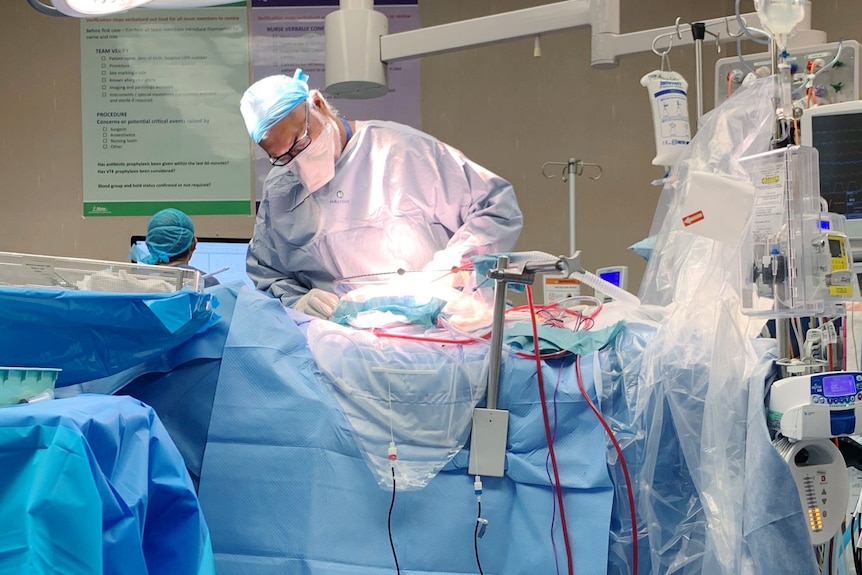-
IP addresses are NOT logged in this forum so there's no point asking. Please note that this forum is full of homophobes, racists, lunatics, schizophrenics & absolute nut jobs with a smattering of geniuses, Chinese chauvinists, Moderate Muslims and last but not least a couple of "know-it-alls" constantly sprouting their dubious wisdom. If you believe that content generated by unsavory characters might cause you offense PLEASE LEAVE NOW! Sammyboy Admin and Staff are not responsible for your hurt feelings should you choose to read any of the content here. The OTHER forum is HERE so please stop asking.
You are using an out of date browser. It may not display this or other websites correctly.
You should upgrade or use an alternative browser.
You should upgrade or use an alternative browser.
What cancers are treated with HIPEC?
- Thread starter ginfreely
- Start date
Dr Melissa Teo, general surgeon and surgical oncologist at Mount Elizabeth Novena Hospital, explains how cytoreductive surgery (CRS) and hyperthermic intraperitoneal chemotherapy (HIPEC) may be used to effectively treat peritoneal cancers.
You're probably familiar with the idea of traditional chemotherapy being used to treat cancer. It involves the use of strong chemicals to kill cancer cells. There are also various chemotherapy drugs available, and depending on the patient's condition, a doctor may choose to use a single drug or a combination of a few.In patients with cancers that have spread to the peritoneum (abdominal lining), heated chemotherapy can be delivered to the abdominal cavity after surgery to act on this lining and potentially kill and eradicate the cancers cells on the peritoneum.
This heated chemotherapy is known as hyperthermic intraperitoneal chemotherapy (HIPEC) and is performed during the same surgical setting after the complete removal of all visible tumours/cancers. This surgery is known as cytoreductive surgery (CRS).
What is cytoreductive surgery (CRS) and HIPEC?

Cytoreductive surgery (CRS) is a surgical procedure referring to the complete removal of all visible tumours/cancers and is particularly useful for cancers of the appendix, colon and rectum and ovary that have spread to involve the peritoneum. Whilst CRS has enabled the removal of all visible tumours/ cancers, HIPEC is useful for addressing any microscopic cancer cells that may still exist within the abdominal cavity. This combined treatment has been shown to reduce the incidence of disease recurrence within the abdomen, leading to prolongation of survival and even cure in selected patients.
There are 2 stages to this combined treatment – CRS and HIPEC and both are performed whilst the patient is under general anaesthesia.
Stage 1 – Cytoreductive surgery (CRS)
- An incision will be made in the patient's abdomen
- The surgeon will then remove any visible cancerous tumours and diseased tissue
- CRS typically takes anywhere between 6 – 10 hours
Stage 2 – HIPEC procedure
This is carried out once all the visible diseased tissue and tumours are surgically removed.- A perfusion machine will heat up the chemotherapy drugs
- The drugs will then pass through the patient's abdomen via catheters
- This typically takes 60 minutes and the patient is carefully monitored throughout the combined procedure
Once HIPEC is completed, the heated chemotherapy is drained out and the abdomen would be rinsed thoroughly and inspected. Bowel anastomoses (joining) would be performed and the surgery would be completed. Most patients would be monitored overnight in the high dependency or intensive care unit but the progression during to recovery is typically fairly rapid after the first 2 – 3 days and most patients are discharged within 7 – 10 days from the day of the CRS and HIPEC.
What types of cancers can CRS and HIPEC treat?
- Appendix tumours (pseudomyxoma peritonei or appendiceal cancer)
- Colorectal cancer
- Ovarian cancer
- Peritoneal cancer
- Peritoneal mesothelioma
- Stomach cancer
Are there any risks or complications in CRS and HIPEC?
The risks of CRS and HIPEC are dependent on the extent of the surgery but the major complications include breakdown of bowel anastomoses (joining) and bleeding. In experienced centres, the risk of major complications should be less than 10%.Other complications include wounds, urinary and lung infections, and deep vein thrombosis, all of which are common to any major surgery.
What is the survival rate for CRS and HIPEC?

The survival after CRS and HIPEC is dependent on the original cancer origin and the completeness of the surgery. In experienced hands, long-term survivals of 80%, 30 – 40% and 50 – 60% can be obtained after complete CRS and HIPEC for appendiceal, colorectal and ovarian cancers.
According to data gathered from 20 studies, the median survival for patients receiving HIPEC surgery as a treatment for colorectal peritoneal metastases (CRPM) was 14.6 – 60.1 months. The systematic review of all the studies also concluded that HIPEC surgery was a safe treatment for CRPM, improving both median and disease-free survival.
HIPEC is an innovative method that has allowed patients with advanced cancers to get the treatment option they need, thereby giving them a second chance at prolonged survival and life.
To learn more about this advanced procedure, make an appointmentwith your specialist to discuss the benefits of HIPEC and to determine if it is the right treatment option for you.
https://www.gleneagles.com.sg/health-plus/article/crs-hipec-cancer-treatment
This is 2018 Spore paper so probably S$100k or more now. Spore research paper so useless talk about cost effectiveness. Don’t treat is the most cost effective lah.
https://pubmed.ncbi.nlm.nih.gov/29948417/#:~:text=Results: The average cost of,S$21,365.19 per life year.
One cancer surgery is S$100k in spore, no wonder USA car T cell therapy is half million usd.This is 2018 Spore paper so probably S$100k or more now. Spore research paper so useless talk about cost effectiveness. Don’t treat is the most cost effective lah.
https://pubmed.ncbi.nlm.nih.gov/29948417/#:~:text=Results: The average cost of,S$21,365.19 per life year.
Oh ya she is super on and said people told her to go live her life and she said people don’t get it, you couldn’t go live your life if you could die and your death was infront of your face. It’s cancer. And she doesn’t care what other people think because it’s her life. It’s her decision and she doesn’t listen to anyone who has not gone through it, even her family. So true so successful so strong so smart so clever woman. Salute!Wow HIPEC saved the life of this polish woman living in Australia. Diagnosed stage 4 stomach cancer at age 47 and now still alive and cancer free at age 51. Australia healthcare very good, she is having scan every three months to check any cancer recurrence.
A new two-step ovarian cancer treatment in Queensland is having success in treating the deadly disease.
Key points:
- About 1,300 Australian women were diagnosed with ovarian cancer last year
- Brisbane GP Chamari Jayawardena was diagnosed with advanced ovarian cancer but now she is cancer free
- This February is Ovarian Cancer Awareness Month so women are being reminded of the symptoms
One of the recipients of the treatment was Brisbane GP Chamari Jayawardena following a diagnosis of advanced ovarian cancer. But she is now cancer-free.
Ovarian cancer is the deadliest of gynaecological cancers with only 49 per cent of patients surviving five years after diagnosis.
The study, which has been running since 2018, involves patients undergoing multiple cycles of chemotherapy to shrink the tumours, which are then surgically removed.
Then, in surgery, doctors flush the patient's abdomen for 90 minutes with a high dose of chemotherapy that's heated to 40 degrees Celsius. Following the surgery, the patient undergoes further cycles of chemotherapy.
Lewis Perrin is the hospital's director of gynaecological oncology and says, so far, the results are encouraging.
They are now investigating whether the treatment may be effective when the chemotherapy drugs are used at body temperature, in a study with the Peter MacCallum Cancer Centre in Melbourne and Chris O'Brien Lifehouse at Sydney's Royal Prince Albert Hospital.
"If this is found to be just as effective, this will open up opportunities for many centres around Australia to be able to use this technique," Dr Perrin said.
Wow even Brisbane healthcare so good.A new two-step ovarian cancer treatment in Queensland is having success in treating the deadly disease.
Key points:
Thirty patients with advanced ovarian cancer have been part of Australia's first feasibility and safety study in using hyperthermic intraperitoneal chemotherapy (HIPEC) to treat ovarian cancer at Brisbane's Mater Hospital.
- About 1,300 Australian women were diagnosed with ovarian cancer last year
- Brisbane GP Chamari Jayawardena was diagnosed with advanced ovarian cancer but now she is cancer free
- This February is Ovarian Cancer Awareness Month so women are being reminded of the symptoms
One of the recipients of the treatment was Brisbane GP Chamari Jayawardena following a diagnosis of advanced ovarian cancer. But she is now cancer-free.
Ovarian cancer is the deadliest of gynaecological cancers with only 49 per cent of patients surviving five years after diagnosis.
The study, which has been running since 2018, involves patients undergoing multiple cycles of chemotherapy to shrink the tumours, which are then surgically removed.
Then, in surgery, doctors flush the patient's abdomen for 90 minutes with a high dose of chemotherapy that's heated to 40 degrees Celsius. Following the surgery, the patient undergoes further cycles of chemotherapy.
Lewis Perrin is the hospital's director of gynaecological oncology and says, so far, the results are encouraging.
They are now investigating whether the treatment may be effective when the chemotherapy drugs are used at body temperature, in a study with the Peter MacCallum Cancer Centre in Melbourne and Chris O'Brien Lifehouse at Sydney's Royal Prince Albert Hospital.
"If this is found to be just as effective, this will open up opportunities for many centres around Australia to be able to use this technique," Dr Perrin said.
The HIPEC procedure involves doctors flushing a patient's abdomen with heated chemotherapy drugs.(Supplied: Mater Hospital )
This one also stage 4 ovarian cancer but in Canada and died. No do HIPEC?
Similar threads
- Replies
- 2
- Views
- 191
- Replies
- 20
- Views
- 681
- Replies
- 3
- Views
- 261
- Replies
- 12
- Views
- 763
